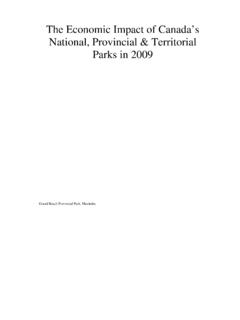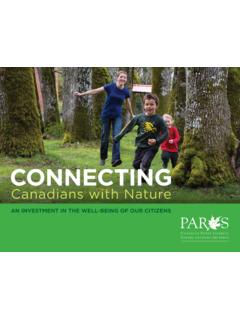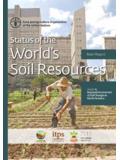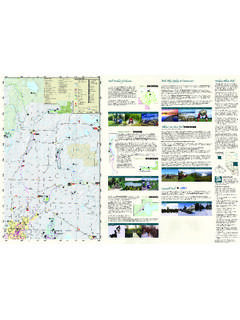Transcription of CANADIAN PARKS AND PROTECTED AREAS
1 CANADIAN PARKS AND PROTECTED AREAS : Helping canada weather climate changeReport of the CANADIAN PARKS Council Climate Change Working GroupReport prepared byThe CANADIAN PARKS Council Climate Change Working Groupfor the CANADIAN PARKS CouncilCitation: CANADIAN PARKS Council Climate Change Working group . 2013. CANADIAN PARKS and PROTECTED AREAS : Helping canada Weather Climate Change. PARKS canada Agency on behalf of the CANADIAN PARKS Council. 52 Climate Change Working group membersKaren Keenleyside (Chair), PARKS CanadaLinda Burr (Consultant), Working group Coordinator Tory Stevens and Eva Riccius, BC ParksCameron Eckert, Yukon ParksJessica Elliott, Manitoba Conservation and Water StewardshipMelanie Percy and Peter Weclaw, Alberta Tourism, PARKS and RecreationRob Wright, Saskatchewan Tourism and ParksKaren Hartley, Ontario ParksAlain H bert and Patrick Graillon, Soci t des tablissements de plein air du Qu becRob Cameron, Nova Scotia Environment, PROTECTED AreasDoug Oliver, Nova Scotia Natural ResourcesJeri Graham and Tina Leonard, Newfoundland and Labrador PARKS and Natural AreasChristopher Lemieux.
2 CANADIAN Council on Ecological AreasMary Rothfels, Fisheries and Oceans CanadaOlaf Jensen and Jean-Fran ois Gobeil, Environment CanadaAcknowledgementsThe CPC Climate Change Working group would like to thank the following people for their help and advice in preparing this report: John Good (CPC Executive Director); Sheldon Kowalchuk, Albert Van Dijk, H l ne Robichaud, Diane Wilson, Virginia Sheehan, Erika Laanela, Doug Yurick, Francine Mercier, Marlow Pellat, Catherine Dumouchel, Donald McLennan, John Wilmshurst, Cynthia Ball, Marie-Jos e Laberge, Julie Lefebvre, Jeff Pender, Stephen Woodley, Mikailou Sy ( PARKS canada ); Paul Gray (Ontario Ministry of Natural Resources); Art Lynds (Nova Scotia Department of Natural Resources).
3 Report design and layout by Alison Scott DesignCover photo: Lake Superior Provincial park , Ontario Ontario PARKS 2013 PARKS canada Agency on behalf of the CANADIAN PARKS CouncilCAT. NO. R62-434/2013 EISBN: 978-1-100-21893-9(Cette publication est aussi disponible en fran ais.)Table of Contents2 | Preface3 | Executive Summary4 | The challenge of climate changeNecessity for adaptation6 | Benefits of ecosystem-based adaptationAdditional benefits of PARKS and PROTECTED areas8 | PARKS and PROTECTED AREAS : part of the solutionStrengthening resilience10 | Roles for PARKS and PROTECTED areasProtecting safe havens for wildlife.
4 Helping plants, animals and their habitats adaptWorking with partners to connect and restore landscapes and seascapesProtecting ecosystem services and supporting healthy communitiesBuilding knowledge and understanding of impacts and solutionsInspiring and engaging Canadians40 | Weathering our future: the natural solutions approachProtect, connect, restoreContribute knowledgeLead by example44 | Working togetherRealizing the potential48 | References52 | Glossary2 canada has a magnificent natural heritage that defines our country in the eyes of Canadians and the world community. Our long tradition of establishment and effective management of PARKS and PROTECTED AREAS whether they be vast, relatively untouched spaces or places for recreational enjoyment, learning and discovery aims to protect our natural and cultural heritage for present and future generations.
5 canada s PARKS and PROTECTED AREAS are important to Canadians for their role in protecting significant landscape and seascape features, conserving biodiversity and cultural resources, and providing opportunities for recreation and connection with nature. In some parts of canada , they may represent the only remaining examples of relatively undisturbed ecosystems. Most of these AREAS are managed by federal, provincial and territorial governments. PARKS and PROTECTED AREAS are increasingly being recognized for another important role they play: as a key means of adapting to and mitigating climate change. The world s climate is changing, and human and natural systems will need to find ways to adapt.
6 CANADIAN provinces and territories, Prefacealong with the federal government, are actively developing strategies to help all sectors of society adapt more effectively to climate change. PROTECTED AREAS are an important part of any climate change strategy, as they protect ecosystems and the services they provide for communities; they store vast quantities of carbon thereby reducing emissions of carbon dioxide from land use change; and they provide safe havens for plants and report highlights the roles of PARKS and PROTECTED AREAS in climate change adaptation and mitigation, and some of the actions taken to date by provincial, territorial and federal PARKS and PROTECTED AREAS agencies as they respond to the challenge of rapid climate change.
7 The report builds on the work of the CANADIAN Council on Ecological AREAS and others who have identified the need for greater collaboration across jurisdictions on this issue. Recognizing this need, the CANADIAN PARKS Council (CPC) Climate Change Working group is coordinating these efforts to build understanding and capacity among jurisdictions to respond to climate change and identify opportunities to work s PARKS and PROTECTED AREAS hold great promise as part of a natural solution to climate change. At the same time, there is much more to do to expand our PROTECTED AREAS networks, connect natural spaces, restore ecosystems and habitats, bring back native species, and inspire and engage Canadians.
8 By reaching across boundaries, sharing best practices and learning from one another, PARKS and PROTECTED AREAS agencies can strengthen their contributions to climate change adaptation and mitigation. The goal of the members of the CPC Climate Change Working group is to encourage the creation of ecologically resilient networks of PARKS and PROTECTED AREAS , connected through sustainably managed landscapes and seascapes, as a key part of the solution to canada s climate change KeenleysideChair, CANADIAN PARKS Council Climate Change Working Group3 Rapid, human-induced global climate change is occurring and will have far-reaching impacts on society, biodiversity and ecosystems.
9 Adaptation measures are thus a necessary complement to reducing greenhouse gas emissions. Ecosystem-based adaptation a complementary approach to other types of climate change adaptation emphasizes the protection of biodiversity, the restoration of ecosystem functions and the sustainable use of resources to help nature and people adapt to climate change. PARKS and PROTECTED AREAS offer certain advantages for implementing ecosystem-based approaches to climate change adaptation. For example, PARKS and PROTECTED AREAS are already being managed to conserve biodiversity and maintain intact and functioning ecosystems; they are effective ways of retaining natural ecosystems and the services they provide; they form the core AREAS necessary for the long-term conservation of biodiversity within broader landscapes and seascapes; and they provide opportunities for public engagement and learning.
10 canada s networks of PARKS and PROTECTED AREAS play an important role in strengthening both our ecological and social resilience to climate change, including: Executive Summary Protecting safe havens for wildlife: helping plants, animals and their habitats adapt; Working with partners to connect and restore landscapes and seascapes; Protecting ecosystem services and supporting healthy communities; Building knowledge and understanding of impacts and solutions; and Inspiring and engaging Canadians. The challenges of climate change are such that CANADIAN PARKS and PROTECTED AREAS agencies must work together to strengthen their contributions to climate change adaptation and mitigation.










